Would you like to get more diners into your restaurant simply by boosting your position in the Google SERPs – search engine result pages – via local SEO? Of course, you would.
With 60% of consumers searching for cafes and local restaurants online, it imperative that you make the most of your restaurant SEO strategy. But restaurant SEO is a little different. You need to focus on local SEO, and that focus has to come from a structured strategy. But we are getting a little ahead of ourselves. First of all, we should define just what SEO for restaurants is.
So, What is SEO for Restaurants?
SEO (Search Engine Optimization) is one of the best marketing strategies any eatery can undertake in 2019. What will a good restaurant SEO campaign consist of? All of the following and more:
- Onsite website optimization, both technical and via backlinking
- Onsite content creation making use of relevant keywords. Optimization of restaurant images, halls and interior design
- Off-site content distribution and promotion
- Creating a consistent, accurate and extensive offsite presence in directories and industry listings.
But where should you get started if you have never even considered that SEO might be beneficial to your restaurant before? Let’s take it step by step:
The best part is Grum is completely affordable from 2 accounts to more than 5. Starting at $10 per month for 2 accounts and growing from there. You even get your first 3 days – FREE!
Determine Your SEO for Restaurants Strategy And Keywords
When implementing a restaurant SEO strategy, the very first thing that needs to be determined is exactly what demographic audience and geographical location(s) you are targeting. By defining this, you can begin to get into the minds of your potential customers and determine what they would type into Google when searching for your restaurant, and how to tailor your SEO strategy and content around those potential customers.
Once you determined your targeting, then you can research keywords that are centred around your potential customers to maximize your Google search results. For restaurants, there are generally two different keyword gropings; broad and niche specific.
Broad Restaurant Keywords
An example of a broad keyword grouping for a restaurant would be simply “Restaurants near me” or “Restaurants in Birmingham”. Depending on the geographical location your restaurant is located in, you would have to take into consideration how competitive your broad keyword is.
There are hundreds of “Restaurants in Birmingham” as it is a big city, so by using a such a broad keyword in that city size, you are facing huge competition, especially as, as you can see below, the top results for that search are all lists, rather than restaurants:
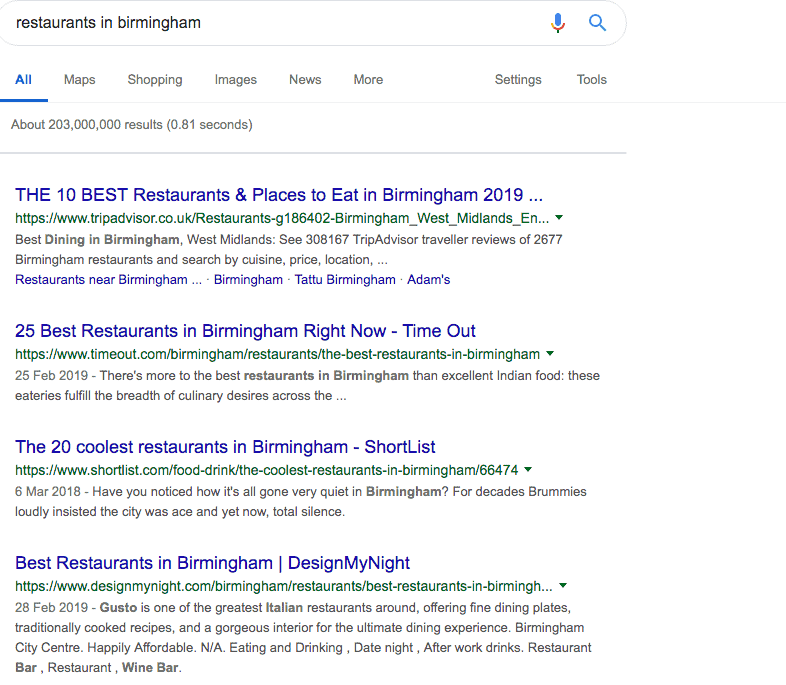
That then would be a bad keyword to aim for (although a spot on one of those lists would be great, but more about those later.) In a smaller setting, a specific area of the city or a small town, broad keywords may be of more use to you, as is the case below for a small area within Birmingham. Comprehensive keyword research will help you determine if that is indeed the case.
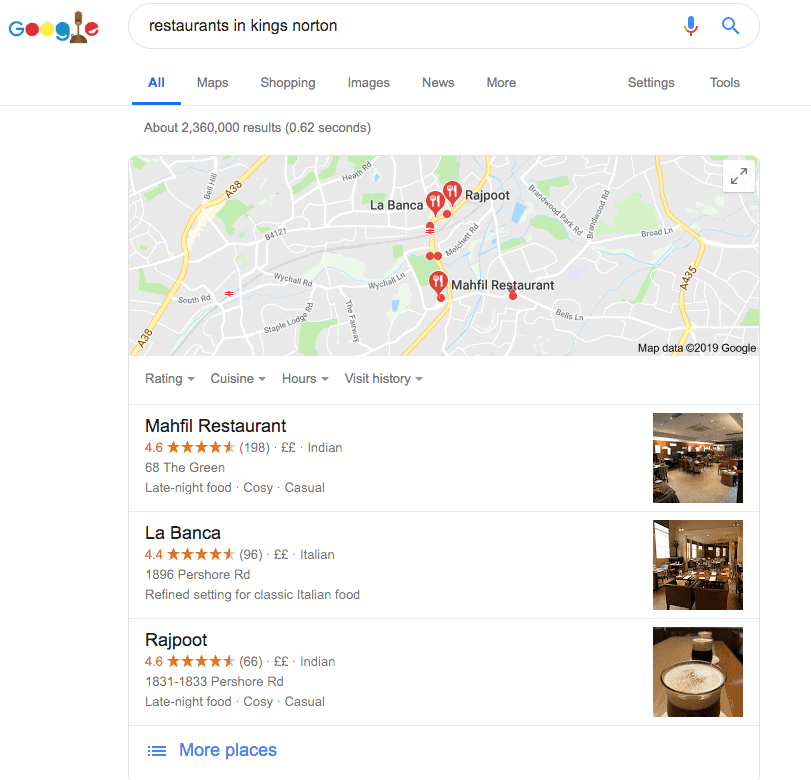
Restaurant Niche Keywords
An example of a niche-specific keyword grouping for a restaurant would be “Vegan Restaurant” or “Vegan Restaurant in Birmingham”. By targeting niche-specific keywords, you will likely face less competition, even in a big city.
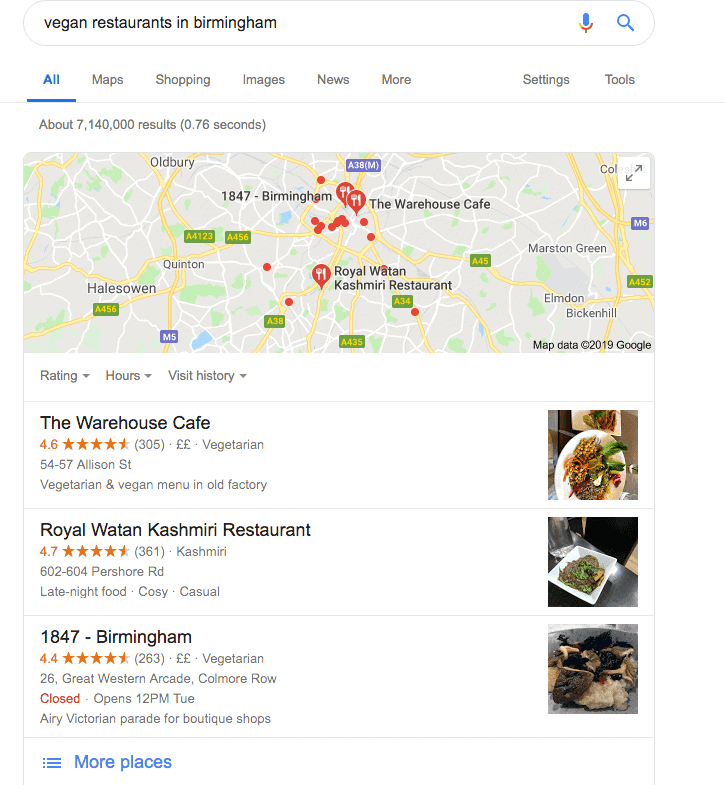
Niche keywords can be tricky, though. Will people be searching for the vegan restaurant only when searching for the kind of cuisine you offer or will they also be searching for vegetarian as well. At that point, given the population’s fondness for vegetarian eating at the moment may mean that it is a keyword that is far more competitive. Again, only a complete keyword research project can truly help you determine that.
They also may be searching for a mood; what about romantic restaurants in Birmingham? Kid-friendly restaurants in Birmingham? People search for those too, could you fit there? And wouldn’t you like to be featured in one of these cool carousels? You can’t pay your way in there with Google Ads; you have to SEO your way in.

By researching relevant keywords for your restaurant, you get first-hand information about your target audience, the search volume of the keywords, and the information they want to know. This will be crucial knowledge to have when you begin to optimize your restaurant website and to create content for it.
Optimizing Your Restaurant Website And Content For Conversions
Of course, what good is bringing traffic to your restaurant’s website if it is not optimized? It’s like going to a car dealership with no cars. As a restaurant, you need to optimize your website. And those efforts begin with technical SEO for restaurants. What do you need to do? Here are some of the basics:
Optimize Your Title Tags
Title tags have a big impact on the performance and SERPS position of your restaurant’s website. You will need to ensure that all your title tags are descriptive, unique and include target keywords so that Google Bots have an easier time determining what you offer so that you can be placed correctly in search results.
However, avoid making use of the same keywords and title tags over and over again as by doing so, you may earn yourself a duplicate content penalty, something you DO NOT want at all.
Optimize Your Meta Descriptions
Meta descriptions are what appear in a search result, and this is where you will need to convince a searcher to click through to your site. A good meta description should explain in 160 characters what the page is all about.

Are you a Fine Dining Restaurant in Fulham that serves French cuisine? Your meta description for your homepage will need to convey that in those 160 characters, – as the one above does – along with why they should choose you over that place a street or so away that offers a seemingly similar dining experience.
Use Schema Markup (Structured Data Markup)
Schema markup is a form of micro-data that goes on your website that assists Google in understanding what your content is on a webpage. For example, if you have schema implemented on your menu page, your menu page may show up on Google search results.
The more optimized your structured data markup is, the more Google will reward you in driving traffic to your website. Schema gives users more relevant info in an organized manner. To implement the schema markup onto your restaurant’s website, use the Google Structured Data Markup Helper.
Make Sure Your Images are Optimized
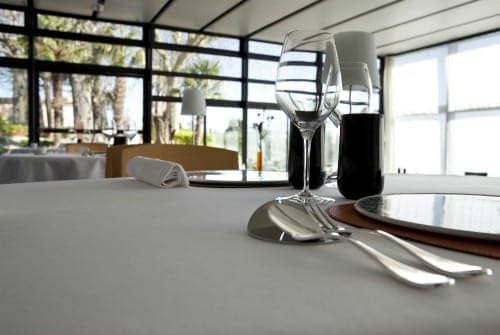
People want to see pictures on a restaurant’s website, lots of them. They are not just looking for images of your food though, they want to see what the inside of the restaurant looks like and some even like to see what the staff looks like.
This means that it only makes sense for you to add these kinds of images to your website, but you have to do so carefully. Not only do the images have to be good – that’s almost a no brainer – they also have to be properly optimized for search bots and humans.
One thing some people do not realize is that search bots are image blind. They can’t ‘see’ what is in an image in the way that humans can. They have to be told with words, via the alt text attached to the image.
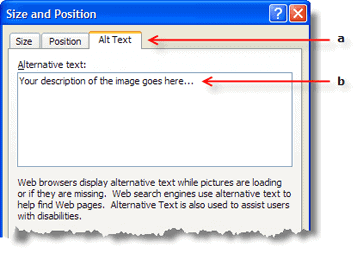
Alt text – literally alternative text – is used for two reasons. Screen readers that are employed by those with visual impairments use to describe the contents of an image and search bots ‘read it’ so that they can determine what is in the image as well. And as many people use Google Image Search – especially when they are hungry and not quite sure what to eat – if your alt text is good you’ll show up in those search results as well.
In addition to making sure that all of the images on your site have great, descriptive alt text that makes use of your keywords, you also need to ensure that they load quickly. Slow websites are something that both users and Google Bots hate, as these figures demonstrate:
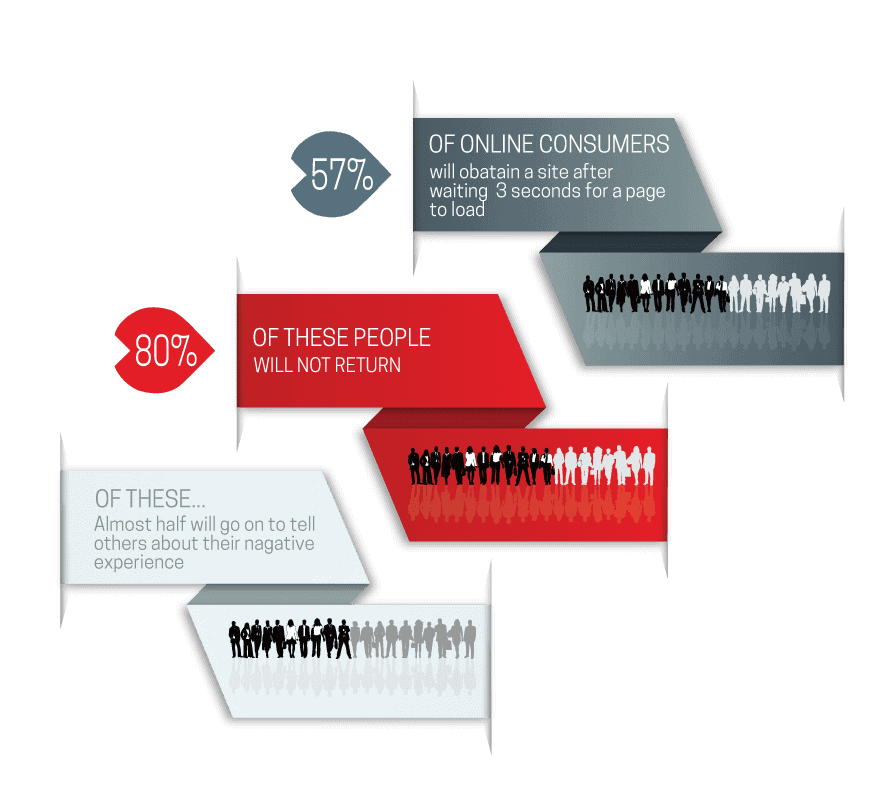
This means making use of image compression and similar techniques to reduce load time without sacrificing image quality. It is a delicate balance, but there are a number of tools that can help you optimize images without having to deal with coding adjustments (they are actually a few that will do it for you automatically, which is always a plus)
Make Sure Your Restaurant Website Is Mobile Friendly
Most of your users will be searching for a restaurant on their mobile device. Thus, it is vital that you have a mobile responsive website for an enhanced user experience. Research shows more restaurant searches in the UK take place on mobile devices than desktops. Thus, it is crucial that your site looks great and functions well on any mobile device, whether it is a small iPhone or a large-screen tablet.
Get the Basic CopyRight
Two of the most important things that your customers need to know? Your restaurant’s address and phone number. They’ll also want to see a menu and learn more about your establishment itself. These copy basics – all original and keyword optimized – should not only be present but very easy to find.
Start Creating MORE SEO Optimized Content
Contrary to what some believe, a restaurant that wants to rank well in the SERPs – and by now you should have realised that you would be crazy if you did not want to – needs to devote time and effort to content creation that goes beyond the menu. A blog can be a great way to do this, and there are a number of good reasons why:
Pure Restaurant SEO – One of the best ways to keep your restaurant website appearing high in search results is with new and relevant content. This content tells search bots more about your site and your business and allows them to constantly review where your site belongs.
SERPs results are never static; they change all the time, but by constantly ‘proving’ where you belong you means that you are more likely to get to the top of a search and stay there.
Update Your Customers Without Changing Your Site – A restaurant blog gives you a dynamic place to tell customers about upcoming events, menu changes, specials and more without having to make significant changes to your website itself, something that can be a real pain, especially when you have lots of other things to do (like cook!)
Collect Valuable Customer Data – Restaurant blogs are a great opportunity way to collect email addresses. Invite customers to sign up for a newsletter and then create a monthly recap of your blog top articles along with other important information – and special offers – that will help keep your restaurant top of mind when your subscribers start to get hungry!
Track and Monitor
Once your initial onsite SEO is complete, you need to make sure that all that you are doing is working for you. There are lots of tools you can use to monitor and analyze your website’s SEO efforts, but you should certainly choose one and make sure you keep an eye on it to determine what is and isn’t working so that changes can be made where needed.
Offsite SEO for Restaurants
Offsite SEO for restaurants is a must as well, and this is where things that might not be as important for other types of businesses but are crucial for restaurant SEO, come into play.
Take Control of All Your Listings
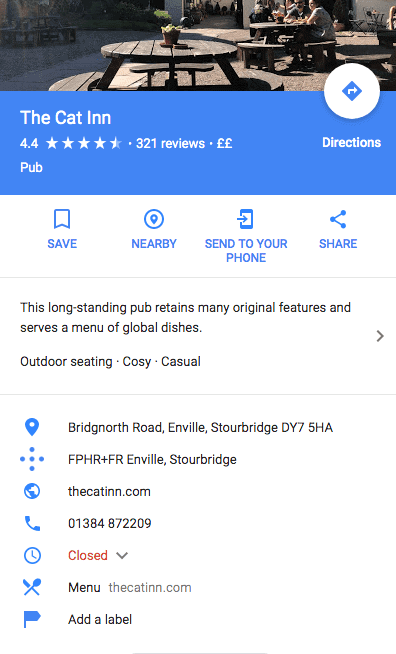
Ensure that all your online listings are consistent. Most search engines like Google don’t like inconsistent listings and negatively impact your Google search rankings. Thus, you’ll want to make sure that all your important information is updated and is the same everywhere.
Make sure that you use the same business name, contact information and address across the web, including on social media platforms, directories, and other business listings you may have. And, above all else, for SEO purposes, claiming and optimizing your Google My Business Listing is a MUST.
Listing your restaurant on “Google My Business” should be one of the first things your restaurant does to improve its Google search rankings. The first thing you will see on most local restaurant search results on Google will be Google Maps with a restaurant location, as seen below.
But that is not all Google My Business allows you do to do. It offers all of the following functionality too:
Quick URLs
Google My Business allows you to add your own URLs for specific actions, such as viewing the menu or reserving a table. Quick links not only help your customers find the right information fast but also give you more space in local search results.
Q And A
The Q and A feature enables you to ask and answer questions about your business. It is imperative you only ask and answer questions that might be useful to your users. More importantly, monitor your customer’s questions and be fast – and first – to answer them when they appear.
Google Posts
With Google Posts, you can add posts of up to 300 words with pictures and link to it with call to actions like “get offer”, “reserve”, and “learn more”. You can use these posts for advertising your specials, promoting events or publishing news about your restaurant
Boost Your Restaurant’s Reviews And Ratings
Over 60% of customers trust peer reviews as a resource when choosing a restaurant. Encourage customers to leave a review. Be sure to respond to all your online reviews, whether negative or positive. It is important that you showcase good reviews on your website as this will help you rank over competitors on local searches in Google.
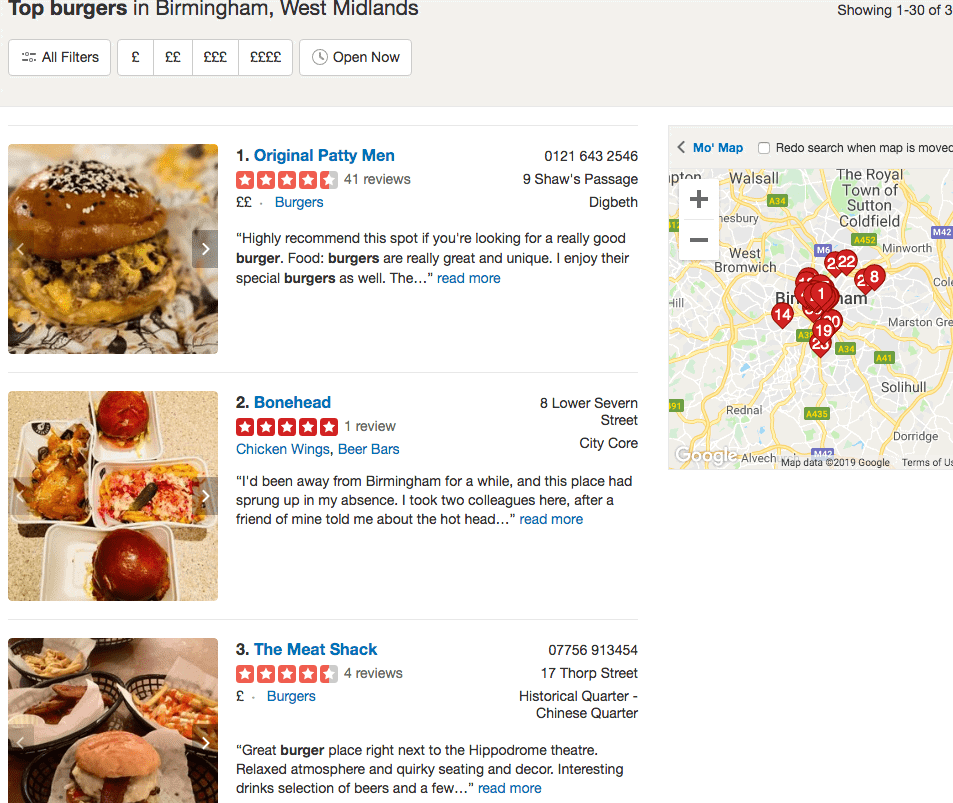
Add Your Restaurant To The Top Relevant And Local Listings
Any reference of your restaurant on a local listing is called a citation. By adding your restaurant to local and relevant listings, you are increasing your credibility and trust with the search engines. The more citations that appear on the web, the higher authority your website will receive, which will result in higher rankings, especially in local search.
Start Local Link Building
Every website benefits in the SERPs from good, relevant backlinks. In the case of a restaurant, as many of those links as possible need to be local links, which calls for a rather different set of link building skills and tactics.
Original content is extremely helpful here. Careful distribution of your blog posts, of original guest posts, getting mentions on those local lists that rank so highly, and social media content can all be utilized together to help you build links as well as drive traffic.
Keep Going
SEO for restaurants is not a one and done process. Holding on to that coveted page one listing once you achieve it calls for consistent, ongoing effort, otherwise, you will lose that spot to your competitors.
If you have made it this far, you have almost certainly realized that SEO for restaurants, in order to be successful, calls for a lot of work. More than you have the time to take on in all likelihood. That’s where we come in. Pearl Lemon’s local SEO team has all the expertise, personnel and resources required to execute successful SEO for restaurants that offer incredible ROI. Ready to learn more? Give us a call; we’re waiting to explain just what SEO for restaurants with Pearl Lemon can do for you.
Notice: Trying to access array offset on value of type null in /home/drhidden/domains/pearllemon.com/public_html/wp-content/plugins/wwpforms/includes/class-frontend.php on line 136








